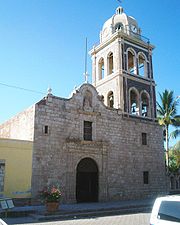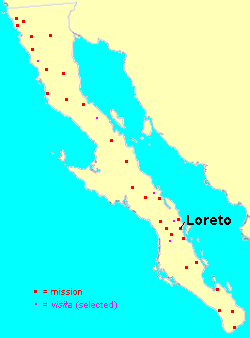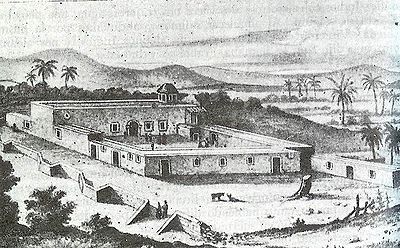
Misión de Nuestra Señora de Loreto Conchó
Encyclopedia


Misión de Nuestra Señora de Loreto Conchó, or Mission Loreto, was founded on October 25, 1697 at the Monqui
Monqui
The Monquis were the Native American inhabitants of the vicinity of Loreto, Baja California Sur, Mexico, at the time of Spanish contact. Probably first encountered by explorers traveling up the Gulf of California during the sixteenth century, they were subjected to some of the peninsula's earliest...
settlement of Conchó in the present city of Loreto
Loreto, Baja California Sur
Loreto was the first Spanish settlement on the Baja California Peninsula. It served as the capital of Las Californias from 1697 to 1777, and is the current seat of the municipality of Loreto in the Mexican state of Baja California Sur...
, Baja California Sur
Baja California Sur
Baja California Sur , is one of the 31 states which, with the Federal District, comprise the 32 Federal Entities of Mexico. Before becoming a state on October 8, 1974, the area was known as the South Territory of Baja California. It has an area of , or 3.57% of the land mass of Mexico and comprises...
, Mexico. Established by the Jesuit
Society of Jesus
The Society of Jesus is a Catholic male religious order that follows the teachings of the Catholic Church. The members are called Jesuits, and are also known colloquially as "God's Army" and as "The Company," these being references to founder Ignatius of Loyola's military background and a...
missionary Juan María de Salvatierra
Juan María de Salvatierra
Juan María de Salvatierra was a Catholic missionary to the Americas.His family was of Spanish origin, the name being written originally Salva-Tierra. Born in Milan, Italy, he studied in the Jesuit college of Parma. It was there that he accidentally came across a book upon the "Indian missions,"...
, this earliest successful mission in Baja California is sometimes considered "head and mother of all the Spanish missions in Upper and Lower California."
Attempts
After Hernán CortésHernán Cortés
Hernán Cortés de Monroy y Pizarro, 1st Marquis of the Valley of Oaxaca was a Spanish Conquistador who led an expedition that caused the fall of the Aztec Empire and brought large portions of mainland Mexico under the rule of the King of Castile in the early 16th century...
' initial failed 1535 attempt to found a colony in the Bay of Santa Cruz (today's La Paz, Baja California Sur
Baja California Sur
Baja California Sur , is one of the 31 states which, with the Federal District, comprise the 32 Federal Entities of Mexico. Before becoming a state on October 8, 1974, the area was known as the South Territory of Baja California. It has an area of , or 3.57% of the land mass of Mexico and comprises...
), the next 150 years were marked with further unsuccessful efforts to colonize Baja California. The most nearly successful of these attempts was the 1683–1685 outpost at San Bruno
Misión San Bruno
The short-lived Jesuit mission of San Bruno was established in 1683 on the Gulf of California of Baja California Sur, about 20 kilometers north of the later site of the town of Loreto....
, only about 20 kilometers north of Loreto, among the Cochimí
Cochimi
The Cochimí are the aboriginal inhabitants of the central part of the Baja California peninsula, from El Rosario in the north to San Javier in the south....
. This failure by Admiral Isidro de Atondo y Antillón
Isidoro de Atondo y Antillon
The Spanish admiral Isidro de Atondo y Antillón is best known for his role in unsuccessful attempts to establish colonies on the Baja California peninsula in 1683–1865....
and the Jesuit missionary Eusebio Francisco Kino
Eusebio Kino
Eusebio Francisco Kino S.J. was an Italian Roman Catholic priest who became famous in what is now northwestern Mexico and the southwestern United States in the region then known as the Pimaria Alta...
led directly to the success at Loreto 12 years later.
After many unsuccessful ventures in Baja California, the government of New Spain and the Spanish crown were reluctant to finance any further attempts. However, Kino's enthusiasm for this potential mission field was persistent. He ultimately persuaded some of his colleagues, including Salvatierra, and the authorities in New Spain to allow the Jesuits to return to the peninsula, but this time on their own responsibility and largely at their own expense.
By the start of 1697 everything was ready for the journey's start at the mouth of the Río Yaqui River in Sonora
Sonora
Sonora officially Estado Libre y Soberano de Sonora is one of the 31 states which, with the Federal District, comprise the 32 Federal Entities of Mexico. It is divided into 72 municipalities; the capital city is Hermosillo....
. Kino was unable to participate, because an Indian rebellion in Sonora required his presence on the mainland. Salvatierra would soon be joined at Loreto by Francisco María Piccolo
Francisco María Piccolo
Francisco María Piccolo was one of the first Jesuit missionaries in Baja California Sur, Mexico. His letters and reports are important sources for the ethnography and early history of the peninsula....
, and they were supported from the mainland by the procurador for the mission, Juan de Ugarte
Juan de Ugarte
Juan de Ugarte was a Jesuit missionary-explorer in Baja California Sur, Mexico, and the successor to Juan María de Salvatierra as head of the peninsula's missions.Ugarte was born in Tegucigalpa, Honduras...
.

Founding
On October 19, 1697, Salvatierra, with a small group of soldiers, disembarked from the galley "Santa Elvira" in the Bay of San Dionisio at 26° N latitude. In the first days after their arrival, the missionary erected a modest structure that served as a chapel, to the front of which they affixed a wooden cross. On October 25 they carried the image of the Virgin of Our Lady of Loreto in a solemn procession, a ritual of faith that claimed the area as Spanish territory. Thus began the Mission Loreto.Loreto served as the base for further expansion of the Jesuit mission system, first in south-central Baja California and then to more remote portions of the peninsula both to the north and to the south. The mission's stone church, which still stands, was begun in 1740. Loreto continued to be the headquarters even after the Jesuits were expelled
Suppression of the Jesuits
The Suppression of the Jesuits in the Portuguese Empire, France, the Two Sicilies, Parma and the Spanish Empire by 1767 was a result of a series of political moves rather than a theological controversy. By the brief Dominus ac Redemptor Pope Clement XIV suppressed the Society of Jesus...
from Baja California and replaced, first by the Franciscans in 1768 and then by the Dominicans
Dominican Order
The Order of Preachers , after the 15th century more commonly known as the Dominican Order or Dominicans, is a Catholic religious order founded by Saint Dominic and approved by Pope Honorius III on 22 December 1216 in France...
in 1773.
Mission Loreto came to an end in 1829, by which time the native Indian neophyte population throughout Baja California Sur had become extinct.
See also
- Spanish missions in Baja CaliforniaSpanish missions in Baja CaliforniaThe Spanish Missions in Baja California comprise a series of religious outposts established by Spanish Catholic religious orders, the Jesuits, the Franciscans and the Dominicans, between 1683 and 1834 to spread the Christian doctrine among the local natives...
- Spanish missions in CaliforniaSpanish missions in CaliforniaThe Spanish missions in California comprise a series of religious and military outposts established by Spanish Catholics of the Franciscan Order between 1769 and 1823 to spread the Christian faith among the local Native Americans. The missions represented the first major effort by Europeans to...
- Spanish colonization of the AmericasSpanish colonization of the AmericasColonial expansion under the Spanish Empire was initiated by the Spanish conquistadores and developed by the Monarchy of Spain through its administrators and missionaries. The motivations for colonial expansion were trade and the spread of the Christian faith through indigenous conversions...
- USNS Mission Loreto (AO-116)USNS Mission Loreto (AO-116)SS Mission Loreto was a Type T2-SE-A2 tanker built for the United States Maritime Commission during World War II. After the war she was acquired by the United States Navy as USS Mission Loreto . Later the tanker transferred to the Military Sea Transportation Service as USNS Mission Loreto ...
, a Mission BuenaventuraUSNS Mission Buenaventura (AO-111)SS Mission Buenaventura was a Type T2-SE-A2 tanker built for the United States Maritime Commission during World War II. After the war she was acquired by the United States Navy as USS Mission Buenaventura . Later the tanker transferred to the Military Sea Transportation Service as USNS Mission...
Class fleet oiler built during World War IIWorld War IIWorld War II, or the Second World War , was a global conflict lasting from 1939 to 1945, involving most of the world's nations—including all of the great powers—eventually forming two opposing military alliances: the Allies and the Axis...
.

